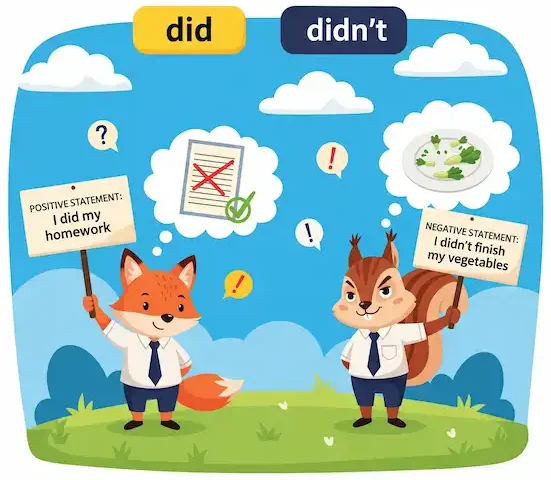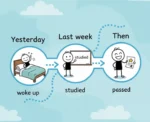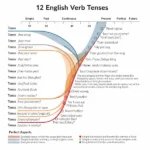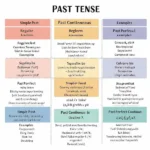Mastering the Past Tense: Questions and Negative Statements
The English past tense can be tricky, but forming past tense questions and negative sentences with “did” and “didn’t” is simple once you learn the rules. This guide will help you master these essential grammar points so you can confidently talk about past events. 📝Learn more about how to use past tense questions and to make negative sentences,
How to Ask Past Tense Questions
To ask a question about a past event, you use the auxiliary verb “did.” The main verb in the sentence then reverts to its base form (the simple present tense). This is a common mistake for new learners, so pay close attention to this rule. The structure is:
Did + subject + base form of the verb + …?
Here’s a breakdown with examples:
- Did you eat breakfast?
- Did he go to the party?
- Did they finish their homework?
- Did it rain yesterday?
Notice how the main verbs (eat, go, finish, rain) are not in the past tense. The word “did” already tells the listener that the question is about the past.
Here’s a chart to help you visualize the structure:
| Question Word (Optional) | Did | Subject | Base Verb | Rest of the Sentence? |
| What | did | you | eat | for lunch? |
| Where | did | they | go | on vacation? |
| When | did | she | arrive | at the office? |
| Why | did | he | leave | early? |
| How | did | it | happen | so fast? |
How to Form Negative Sentences in the Past Tense
When you want to say that something didn’t happen in the past, you use the word “didn’t” (the contraction of “did not“). Just like with questions, the main verb reverts to its base form.
The structure is:
Subject + didn’t + base form of the verb + …
Here are some examples:
- I didn’t eat breakfast.
- She didn’t go to the party.
- They didn’t finish their homework.
- It didn’t rain yesterday.
Again, the word “didn’t” tells us the action did not happen in the past. Therefore, you do not need to use the past tense form of the main verb.
Why Do We Use “didn’t”?
Using “didn’t” is much more common in everyday speech and writing than “did not.” The contraction makes the language sound more natural and conversational. It’s a good practice to use contractions to sound more like a native speaker.
Here’s a chart showing the structure with different subjects:
| Subject | Didn’t | Base Verb | Rest of the Sentence |
| I | didn’t | see | the movie. |
| You | didn’t | call | me back. |
| He/She/It | didn’t | like | the food. |
| We | didn’t | work | on the project. |
| They | didn’t | understand | the instructions. |
Practice Makes Perfect!
The best way to remember these rules is to practice them. Try converting simple past tense sentences into questions and negative statements.
Simple Past Statement: I went to the store.
- Question: Did you go to the store?
- Negative: I didn’t go to the store.
Simple Past Statement: He finished his dinner.
- Question: Did he finish his dinner?
- Negative: He didn’t finish his dinner.
Remember these key takeaways:
- For questions, use Did + subject + base verb?
- For negative sentences, use subject + didn’t + base verb.
- The main verb is always in its base form when using “did” or “didn’t.” 🧠
Forming Questions ❓
- Did she ______ (finish) her homework last night?
- What did you ______ (eat) for lunch yesterday?
- Did they ______ (go) to the park on Sunday?
- Where did he ______ (find) that old book?
- Did it ______ (rain) during the night?
Forming Negative Sentences 🚫
- I didn’t ______ (see) the movie with my friends.
- She didn’t ______ (call) me back after the meeting.
- We didn’t ______ (like) the food at that new restaurant.
- They didn’t ______ (understand) the instructions.
- He didn’t ______ (know) the answer to the question.
Here is a PDF worksheet you can download with 25 past tense practice sentences using Did Didn’t. The answers are on a separate page.
Additional Helpful Information
More help with Do and Does – Do and Does: Simple English Questions for Beginners
Authoritative and Additional Resources 📚
- British Council – Past Simple: A trusted resource with explanations and exercises for the past simple tense.
- Purdue Online Writing Lab (OWL) – Simple Past Tense: The OWL provides detailed grammar explanations for academic and general use.
- Cambridge Dictionary – Did: A reference for how “did” functions as a helping verb in questions and negative statements.




